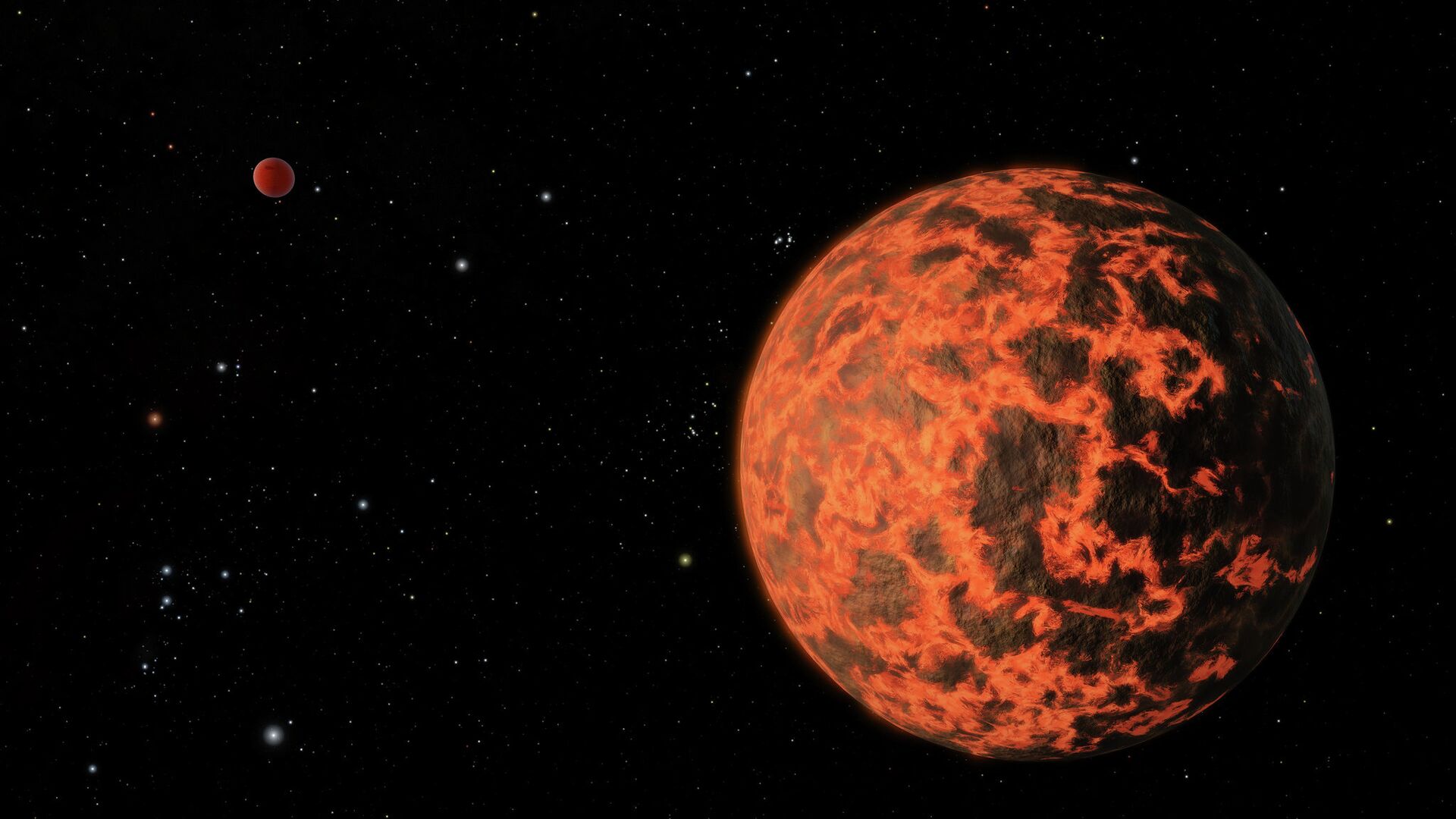https://en.sputniknews.africa/20231104/1063309740.html
Seven Scorching Planets Discovered Using Decommissioned Telescope Data
Seven Scorching Planets Discovered Using Decommissioned Telescope Data
Sputnik Africa
The Kepler Space Telescope, named after the astronomer Johannes Kepler, is a space telescope launched by NASA in 2009 and decommissioned in 2018. Its mission... 04.11.2023, Sputnik Africa
2023-11-04T14:37+0100
2023-11-04T14:37+0100
2023-11-04T14:37+0100
international
earth
space
nasa
science
research
https://cdn1.img.sputniknews.africa/img/07e7/0b/04/1063309917_0:0:2048:1152_1920x0_80_0_0_34117986d7154e8266c211bbac275634.jpg
Researchers poring over data from the National Aeronautics and Space Administration's (NASA) decommissioned Kepler space telescope have identified seven planets, all of which endure a level of stellar heat per unit surface area exceeding that experienced by planets in the solar system.Kepler-385 presents a unique cosmic assembly where each of its seven constituent planets surpasses Earth in scale yet remains modest compared with Neptune. This planetary system is in the company of an exclusive assembly of cosmic bodies, each with a retinue of more than six planets or probable planetary bodies.Within the fresh Kepler inventory, which lists 4,400 possible planets, Kepler-385 is a prime example, contributing to the compendium that spans beyond 700 systems with several planets.A research scientist at NASA's Ames Research Center in California's Silicon Valley, Jack Lissauer, told reporters about the compilation of the most precise list thus far from Kepler planet hopefuls and their characteristics. He emphasized the significance of this new catalog, which was detailed in a paper he wrote, by noting that it would enhance the astronomical community's understanding of exoplanets, most of which were discovered by NASA's Kepler mission.The centerpiece of the Kepler-385 system is a star that mirrors the characteristics of our sun but reveals itself to be 10 percent larger and 5 percent more scorching. Its two innermost planets, marginally bigger than Earth, are rocky spheres that may boast slender veils of atmosphere. Orbiting farther out, five substantial planets, all with a radius twice that of Earth, are anticipated to be swathed in substantial atmospheric layers.The detailed characterization of the Kepler-385 system highlights the excellence of the most recent exoplanet inventory. Unlike previous Kepler mission records, which concentrated on quantifying the frequency of planets orbiting other stars, this research aims to curate an exhaustive directory with precise data about each celestial configuration, facilitating breakthroughs such as the discovery of Kepler-385.The latest catalog, incorporating refined stellar metrics and planetary transit computations, reveals a trend: star systems hosting many transiting planets tend to have those planets orbiting in more uniform, circular paths than their less populated counterparts.This insight comes from the Kepler mission's rich dataset, which, despite being wrapped up in 2013 and its extended mission ending in 2018, continues to shed light on the structure of planetary systems. Kepler's data trove continues to be a source of revelations, not only confirming the prevalence of planets over stars in the galaxy, but also enhancing our perception of these planets' orbital arrangements.
https://en.sputniknews.africa/20231017/brics-nations-unite-for-scientific-progress-at-astronomy-working-group-meeting-in-south-africa-1062879576.html
earth
space
Sputnik Africa
feedback@sputniknews.com
+74956456601
MIA „Rossiya Segodnya“
2023
Chimauchem Nwosu
https://cdn1.img.sputniknews.africa/img/07e8/06/0b/1066992175_0:0:278:278_100x100_80_0_0_b5f6eaa3b85dbfcd0266ea860848a996.jpg
Chimauchem Nwosu
https://cdn1.img.sputniknews.africa/img/07e8/06/0b/1066992175_0:0:278:278_100x100_80_0_0_b5f6eaa3b85dbfcd0266ea860848a996.jpg
News
en_EN
Sputnik Africa
feedback@sputniknews.com
+74956456601
MIA „Rossiya Segodnya“
Sputnik Africa
feedback@sputniknews.com
+74956456601
MIA „Rossiya Segodnya“
Chimauchem Nwosu
https://cdn1.img.sputniknews.africa/img/07e8/06/0b/1066992175_0:0:278:278_100x100_80_0_0_b5f6eaa3b85dbfcd0266ea860848a996.jpg
international, earth, space, nasa, science, research
international, earth, space, nasa, science, research
Seven Scorching Planets Discovered Using Decommissioned Telescope Data
The Kepler Space Telescope, named after the astronomer Johannes Kepler, is a space telescope launched by NASA in 2009 and decommissioned in 2018. Its mission is to discover Earth-sized planets orbiting other stars. Kepler's legacy data continues to enhance our understanding of the galaxy's planetary systems.
Researchers poring over data from the National Aeronautics and Space Administration's (NASA) decommissioned Kepler
space telescope have identified seven planets, all of which endure a level of stellar heat per unit surface area exceeding that experienced by planets in the solar system.
Kepler-385 presents a unique cosmic assembly where each of its seven constituent planets surpasses Earth in scale yet remains modest compared with Neptune. This planetary system is in the company of an exclusive assembly of cosmic bodies, each with a retinue of more than six planets or probable planetary bodies.
Within the fresh Kepler inventory, which lists 4,400 possible planets, Kepler-385 is a prime example, contributing to the compendium that spans beyond 700 systems with several planets.
A research scientist at NASA's Ames Research Center in California's Silicon Valley, Jack Lissauer, told reporters about the compilation of the most precise list thus far from Kepler planet hopefuls and their characteristics. He emphasized the significance of this new catalog, which was detailed in a
paper he wrote, by noting that it would enhance the astronomical community's understanding of exoplanets, most of which were discovered by
NASA's Kepler mission.
The centerpiece of the Kepler-385 system is a star that mirrors the characteristics of our sun but reveals itself to be 10 percent larger and 5 percent more scorching. Its two innermost planets, marginally bigger than Earth, are rocky spheres that may boast slender veils of atmosphere. Orbiting farther out, five substantial planets, all with a radius twice that of Earth, are anticipated to be swathed in substantial atmospheric layers.
The detailed characterization of the Kepler-385 system highlights the excellence of the most recent exoplanet inventory. Unlike previous Kepler mission records, which concentrated on quantifying the frequency of planets orbiting other stars, this research aims to curate an exhaustive directory with precise data about each celestial configuration, facilitating breakthroughs such as the discovery of Kepler-385.
The latest catalog, incorporating refined stellar metrics and planetary transit computations, reveals a trend: star systems hosting many transiting planets tend to have those planets orbiting in more uniform, circular paths than their less populated counterparts.
This insight comes from the Kepler mission's rich dataset, which, despite being wrapped up in 2013 and its extended mission ending in 2018, continues to shed light on the structure of planetary systems. Kepler's data trove continues to be a source of revelations, not only confirming the prevalence of planets over stars in the galaxy, but also enhancing our perception of these planets' orbital arrangements.



